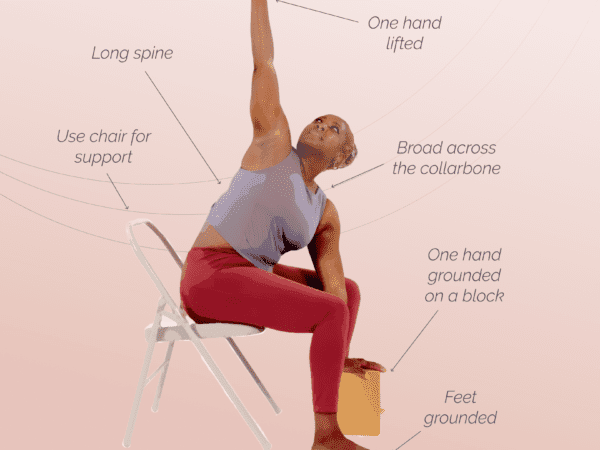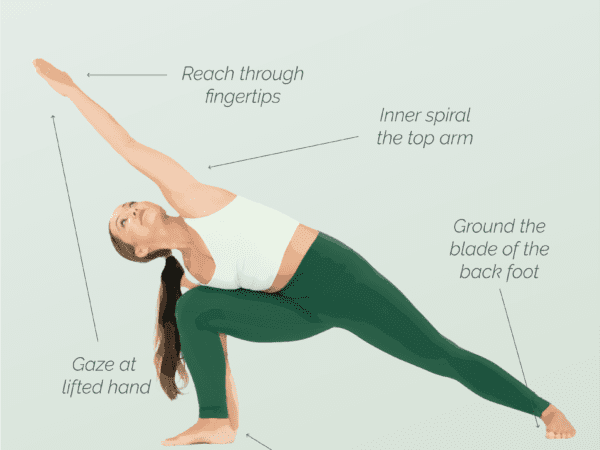Modified crow pose, also known as bakasana, is a popular yoga pose that offers a multitude of benefits for both the body and mind. Crow pose is one of the most commonly practiced arm balances. Mastering it can enhance your strength, balance, and focus. It can be challenging if you haven’t developed the strength to hold the posture. There are ways to modify the pose so you can do it even if you haven’t developed the strength for it yet. Let’s look at the steps to achieve the modified crow pose, providing helpful tips and variations along the way. Get ready to soar to new heights in your yoga practice as we delve into the world of modified crow pose.
Benefits of modified crow pose
Strengthens the arms, wrists, and shoulders: Modified crow pose requires you to support some of your body weight on your hands, which helps to build strength in these areas. As you practice the pose on a block over time you’ll be able to support more of your body weight.
Tones the core muscles: As you engage your abdominal muscles to lift your legs off the ground, modified crow pose helps to strengthen and tone your core.
Improves balance and coordination: Balancing on your hands in modified crow pose challenges your sense of balance and improves coordination between your upper and lower body.
Enhances focus and concentration: Holding the pose requires concentration and focus, helping to calm the mind and improve mental clarity.
Stretches the upper back and opens the chest: Modified crow pose provides a gentle stretch to the upper back and chest, helping to improve posture and relieve tension in these areas.
Boosts confidence: As you progress in your practice and master modified crow pose, it can boost your confidence and self-esteem, knowing that you have achieved a challenging pose.
Stimulates digestion: The compression of the abdomen in modified crow pose can help stimulate digestion and improve overall digestive health.
Energizes the body: This pose activates the muscles and increases blood flow, leaving you feeling invigorated and energized.
Cultivates mindfulness: Practicing modified crow pose encourages you to be present in the moment, fostering a sense of mindfulness and self-awareness.
Offers a sense of accomplishment: Successfully performing modified crow pose can give you a sense of accomplishment and satisfaction, motivating you to continue exploring your yoga practice. You’ll notice yourself getting stronger and stronger. Eventually, you’ll be able to lift your feet toward your hips and not use a block to balance at all. Practicing this pose can help you overcome fear of falling and balancing on your arms.
Contraindications of modified crow pose
While modified crow pose can be a beneficial asana for many individuals, it is important to be aware of any contraindications or precautions before attempting the pose. Here are some contraindications to consider:
Wrist or shoulder injuries: If you have any existing wrist or shoulder injuries, it is best to avoid or modify modified crow pose to prevent further strain or discomfort.
Carpal tunnel syndrome: Individuals with carpal tunnel syndrome should approach modified crow pose with caution, as it can put additional pressure on the wrists.
Pregnancy: Pregnant individuals should avoid practicing modified crow pose, as it involves balancing on the hands and may not be suitable during pregnancy.
High blood pressure: If you have high blood pressure, it is advisable to avoid inversions, including modified crow pose, as they can increase blood pressure.
Recent abdominal surgery: If you have had recent abdominal surgery, it is important to consult with your healthcare provider before attempting modified crow pose, as it may strain the abdominal muscles.
Lack of upper body strength: If you are new to yoga or have limited upper body strength, it is recommended to build strength and stability before attempting modified crow pose to avoid potential injuries.
Always listen to your body and consult with a qualified yoga instructor or healthcare professional if you have any concerns or specific health conditions before attempting modified crow pose. They can provide personalized guidance and modifications to ensure your safety and well-being.
Step by step instructions for modified crow pose
To practice modified crow pose with the support of two blocks under your feet, follow these step-by-step instructions:
Begin by placing two blocks on top of each other.
Stand with the blocks between your feet.
Hinge forward and place your hands on the ground and put your feet on the blocks, so your are in a squatting position.
Gently lift your heels off the ground and shift your weight forward, bringing your knees to rest on the backs of your upper arms.
Keep your gaze focused slightly forward to maintain balance and stability.
Engage your core muscles and slowly start to shift more weight onto your hands.
Use the blocks to help you stay balanced on your hands.
As you feel comfortable, begin to lift your feet off the blocks, balancing completely on your hands. This will happen over time.
Find your balance and hold the pose for a few breaths, maintaining a strong connection between your hands and the blocks.
Keep your core engaged and your gaze steady as you continue to breathe deeply.
To release the pose, gently lower your feet back down to the blocks and then release your knees from your upper arms.
Remember to listen to your body and only go as far as feels comfortable for you. With regular practice and patience, you can gradually build strength and balance to eventually perform Modified Crow Pose without the support of blocks.
Additional Tips
Here are some additional tips to help you as you work towards practicing Modified Crow Pose:
Warm up: Before attempting Modified Crow Pose, it’s important to warm up your body. Engage in some gentle stretching and warm-up exercises to prepare your wrists, shoulders, and core muscles. You’ll need both strength and flexibility in the wrists for this pose.
Strengthen your wrists and arms: Building strength in your wrists and arms will help you support your body weight in Modified Crow Pose. Incorporate exercises like wrist stretches, forearm planks, and push-ups into your regular routine.
Practice core exercises: Strengthening your core muscles will provide stability and support in Modified Crow Pose. Include exercises such as plank variations, boat pose, and bicycle crunches to target your abdominal muscles.
Start with modifications: If you’re not yet able to balance on your arms, use props like blocks or blankets to provide support under your feet. Gradually work on shifting more weight onto your hands and reducing the support from the props over time.
Focus on alignment: Pay attention to your alignment in Modified Crow Pose. Keep your elbows slightly bent, shoulders away from your ears, and engage your core to maintain stability. Avoid sinking into your shoulders or rounding your back.
Use a spotter or wall support: If you’re feeling unsure or want an extra layer of support, practice Modified Crow Pose with a spotter or near a wall. They can provide assistance or act as a support if needed.
Practice regularly: Consistency is key when working towards any yoga pose. Set aside regular practice sessions to gradually build strength, balance, and confidence in modified crow pose.
Be patient and listen to your body: Remember that progress takes time. Be patient with yourself and listen to your body’s limits. Avoid pushing yourself too hard and honor any discomfort or pain by modifying or taking a break when needed.
By incorporating these tips into your practice, you can gradually progress towards mastering modified crow pose and enjoy the benefits it offers. Remember to always practice with mindfulness, respect your body’s limitations, and seek guidance from a qualified yoga instructor if needed.
Join Omstars to get instant access to yoga classes, guided meditation, and more. Download our app to have all of that on your phone whenever you need it. Get started today.









